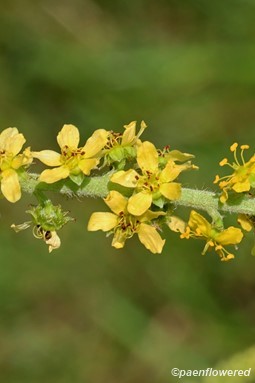Agrimonia parviflora
Agrimonia parviflora swamp agrimony
Swamp agrimony is a tall native perennial that grows in sunny to lightly shaded wet habitats, including swamps, floodplain woods, soggy thickets, prairie swales, and roadside ditches. Its fibrous, rhizomatous roots allow it to form small colonies. The stout, upright stems are unbranched or sparingly branched, covered with long white to light brown hairs, sometimes sticky to the touch.
Leaves are long (up to 2 ft) and compound, with 9–17 narrow primary leaflets and 1–4 pairs of smaller leaflets nestled between. Leaflets are typically arranged opposite or sub-opposite along the central stalk, giving the leaf a balanced, feathery appearance. Primary leaflets measure 2–3 inches long, narrowly lance-shaped to elliptic, with wedge-shaped bases, pointed tips, and coarsely toothed margins. The upper surface is yellow-green and smooth, while the underside is short-hairy, especially along the veins. Secondary leaflets are much smaller, usually less than 1 inch long. Both the stalk and midrib of each compound leaf are hairy. At the base of each leaf are large, fan-shaped stipules that are coarsely toothed or lobed.
The flowering stem ends in a tall, spike-like raceme 3⁄4 –2 1⁄2 ft long, sometimes accompanied by smaller racemes from the upper leaf axils. Flowers are tiny (about 1⁄4 in. across) and widely spaced along the raceme. Each flower has five yellow petals, about 10 stamens, and a central pistil surrounded by a tubular green calyx with 10 ribs. Flowers open from the bottom upward, with only a few open at once, giving the plant a prolonged but modest blooming period in mid to late summer.
Fruits are small burs, about 1⁄8–1⁄4 in. across, with hooked bristles around the rim of the persistent calyx. These easily cling to clothing, fur, or feathers, aiding seed dispersal. Immature fruits are green, turning brown when mature. Each fruit contains 1–2 seeds.
Habitat & Range
Frequent in moist woods, bottomland forests, swampy thickets, fens, seeps, and along ditches and streambanks. Thrives in low, saturated areas where water lingers and the soil remains rich.
Prefers partial to full sun and moist, well-drained soils. It tolerates loamy, sandy, silty, or gravelly soils, as well as temporary spring flooding.
Found mostly in the south of the state. See distribution map at BONAP.
Range: Native to eastern and central North America, with a range extending from Ontario and the northeastern United States (including Connecticut and Massachusetts), southward to Georgia, and westward through the Midwest and Great Plains, including Illinois, Missouri, and parts of Texas.
| EMP: | FACW |
|---|---|
| NCNE: | FAC |
Phenology
Flowers July to early September.
Characteristics
Inflorescence tall, wand-like raceme ¾–2½ ft long; flowers spaced apart; blooms from bottom upward
Flowers tiny (¼″), yellow, 5 petals, ~10 stamens, central pistil; calyx tubular with 10 ribs
Leaves long (up to 2 ft), compound with 9–17 narrow lance-shaped leaflets interspersed with smaller ones; margins sharply serrate; hairy stalk and midrib; large fan-shaped stipules at base
Stems stout, upright, unbranched or few branches; covered in long white or light brown hairs (sometimes sticky)
Fruit bur-like, 1⁄8–1⁄4″ long; outer bristles hooked and spreading around rim of persistent calyx, inner bristles erect; contains 1-2 seeds
Height 2½–5 ft (max to 6 ft)
Identification Tips
Swamp Agrimony can be distinguished from other agrimonies by its narrow leaflets and the higher number of primary leaflets (9–17, sometimes more). The tall, wand-like racemes with small, scattered yellow flowers and the small burs with hooked bristles are also key features.
Plant Codes
S-rank: S5 (Secure)
G-rank: G5 (Secure)
Ecology
Flowers provide nectar and pollen to small native bees and syrphid flies. Other insects feed on the plant, including aphids, gall midges, sawfly larvae, and leaf-mining moths such as Anacampsis agrimoniella (Gelechiidae family) and Coptotriche agrimoniella (Tischeriidae family). The foliage, high in tannins, is usually avoided by grazing mammals. Birds may use fresh agrimony leaves in their nests, possibly for their aromatic, parasite-reducing qualities.





Comments
Have you spotted this plant in your area? We'd love to hear about your experience! Share your comments or questions about the plant below. Comments are moderated before posting.